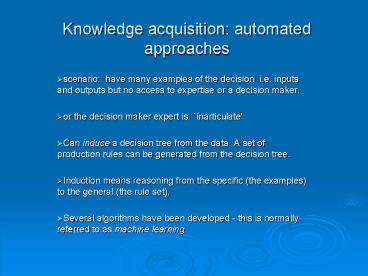Knowledge acquisition: automated approaches - PowerPoint PPT Presentation
1 / 13
Title:
Knowledge acquisition: automated approaches
Description:
... to knowledge representation (and consequently implementation) ... Analysis representation. For declarative/'factual' knowledge. You could ... representation ... – PowerPoint PPT presentation
Number of Views:79
Avg rating:3.0/5.0
Title: Knowledge acquisition: automated approaches
1
Knowledge acquisition automated approaches
- scenario have many examples of the decision
i.e. inputs and outputs but no access to
expertise or a decision maker. - or the decision maker expert is inarticulate
- Can induce a decision tree from the data. A set
of production rules can be generated from the
decision tree. - Induction means reasoning from the specific (the
examples) to the general (the rule set). - Several algorithms have been developed - this is
normally referred to as machine learning
2
Knowledge acquisition automated approaches
- A manual example A loan application advisor
- the following table contains examples of the
decision, can we induce any knowledge from it?
3
Knowledge acquisition automated approaches
- We could infer the following 3 rules
- 1 IF income is 70 000 or more THEN approve
the loan - explains' Ms Green and Ms Brown
- 2 IF income is 30 000 or more AND age is
at least 42 AND there are no dependents AND
assets are at least 250 000 THEN approve the
loan - explains' Ms Rich, Mr Black, Mr Smith
- 3 IF income is between 30 000 and 50 000
- AND assets are at least 100 000 THEN
approve the loan - explains' Mr White and Mr Smith
4
Knowledge acquisition automated approaches
- These are examples of production' rules.
- They express knowledge'
- They can only tell us whether we should approve
the loan. - When all clauses on the left hand side of a rule
are true then the rule fires - and provides a decision.
- The order in which the rules are processed' can
vary.
5
Knowledge acquisition automated approaches
- This is different than writing an selection block
using the IF statement - i.e
- IF income is 70 000 or more
- then approve the loan
- ELSE
- IF income is 30 000 or more
- AND age is at least 42
- AND there are no dependents
- AND assets are at least 250 000
- then approve the loan
- ELSE
- IF income is between 30 000
and 50 000 - AND assets are at least 100
000 - then approve the loan
- ELSE
- reject loan
- ENDIF
- ENDIF
- ENDIF
6
Knowledge acquisition automated approaches
- What about the following examples?
- 1 Mr Blue who earns 45 000 p.a. has assets
worth 110, 000, - is 30 years of age and has no dependents
- applies for a loan and is rejected.
- problem the rule base approves the loan
rule 3 fires - could add an extra clause to rule 3 i.e.
AND has at least one dependent - 2 Mrs Mayberry who earns 70 000, has no
assets, - is 35 years old and has one dependent
- applies for a loan and is also rejected
- a more serious problem we have conflict
in our examples
7
Knowledge acquisition
- Multiple Experts
- may have more than one expert to deal with
- How to you integrate their opinion?
- How do you deal with conflict or
disagreement? - How do you handle multiple lines of
reasoning?
8
Knowledge representation analysis representation
Interviews Protocol analysis Repertory grid
Induction etc
9
Analysis representation
- Problem
- What is an effective way of documenting what we
are finding out about - the problem domain and the decision making?
- Hopefully the transition from documentation to
knowledge representation (and consequently
implementation) is reasonably straight forward. - Some knowledge acquisition techniques
- particularly the semi-automated and automated
ones - generate their own documentation techniques
10
Analysis representation
- For example
- An automated technique such as induction can
generate a decision tree, which can be expressed
as a selection block (i.e. a series of nested IF
statements) which in turn can be written as a set
of production rules. - A semi-automated technique such repertory grid
analysis can generate schematics such as rating
grids and distance matrices. - What about results from the various manual
acquisition techniques?
11
Analysis representation
- For declarative/'factual' knowledge
- You could consider the use of
- a glossary meaning of technical terms
(or concepts) - classification trees group concepts
together - according to common properties.
- and /or a conceptual graph/ semantic
network approach - documents the relationships between
concepts in the problem domain. - different relationship types can be
documented - A has an attribute B
- A has an association with B
- A is a component of B
- A takes place in B etc..
12
Analysis representation
- Techniques such as conceptual graphs, semantic
networks, influence diagrams etc - can be formal or informal
- formality implies that there is a syntax (or
grammar') - and a set of rules governing how the graph (or
network) can be developed. - This is useful because it implies that the
representation scheme may be implementable (in a
computing sense) - informality (or perhaps semi-informality)
implies only general guidelines with some rules. - Generally such schematics are not implementable.
13
Analysis representation
- An example of an informal conceptual
graph/semantic network for a hospital
key
concept
hospital
is-part-of
the health system
relationship
contains
contains
direction
surgeon
ward
operating theatre
uses
attr
attr
operates on
located in
patient
bed
ward
number of beds































